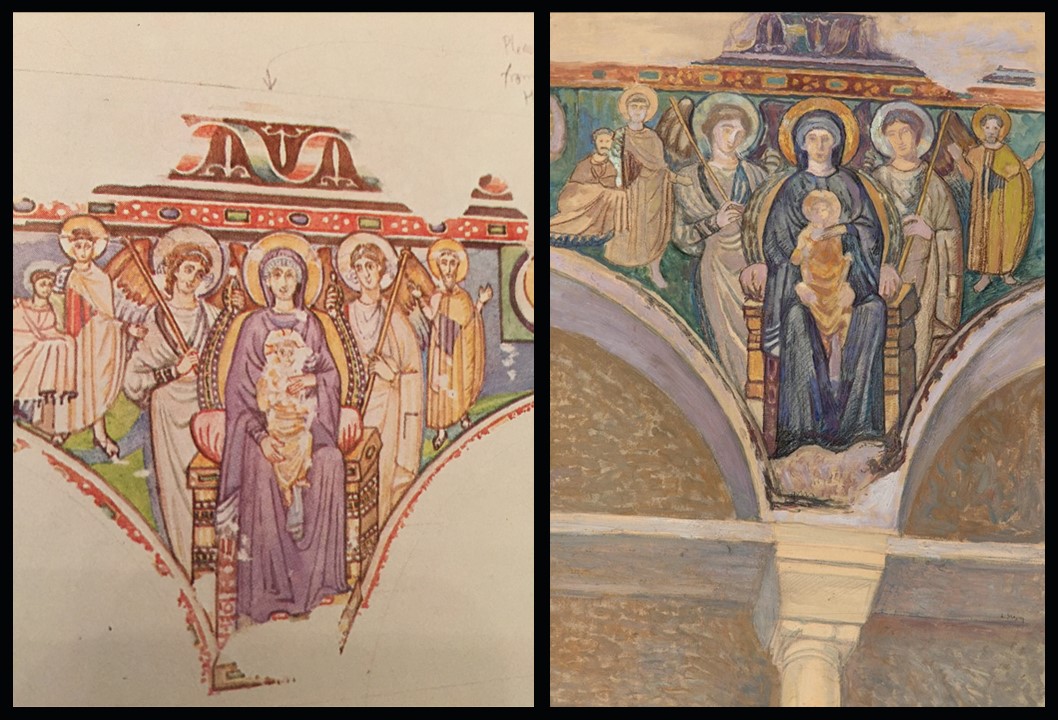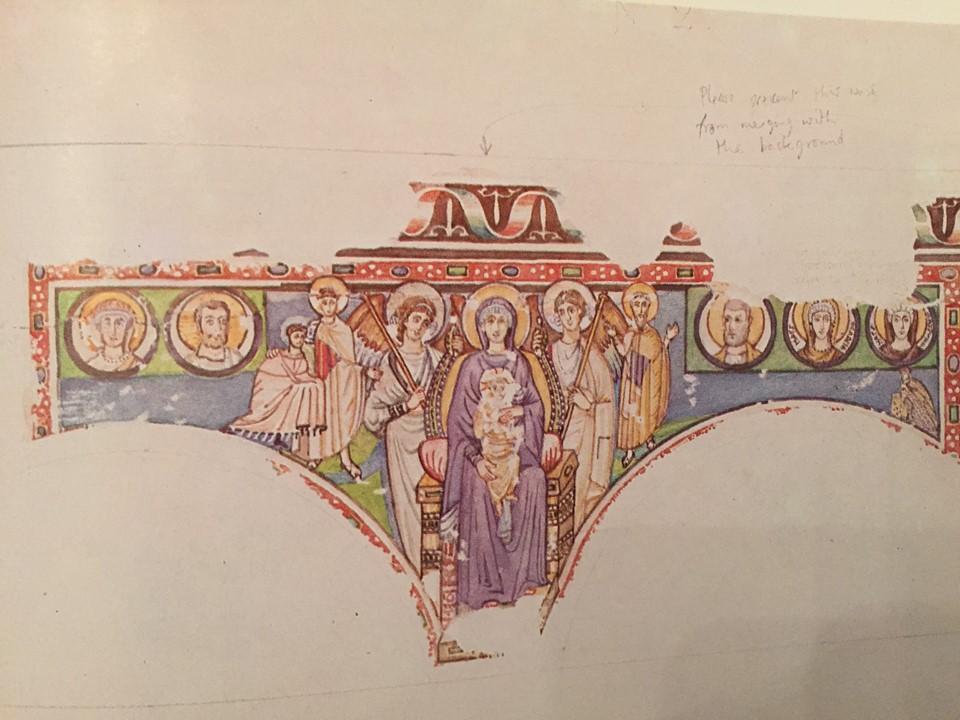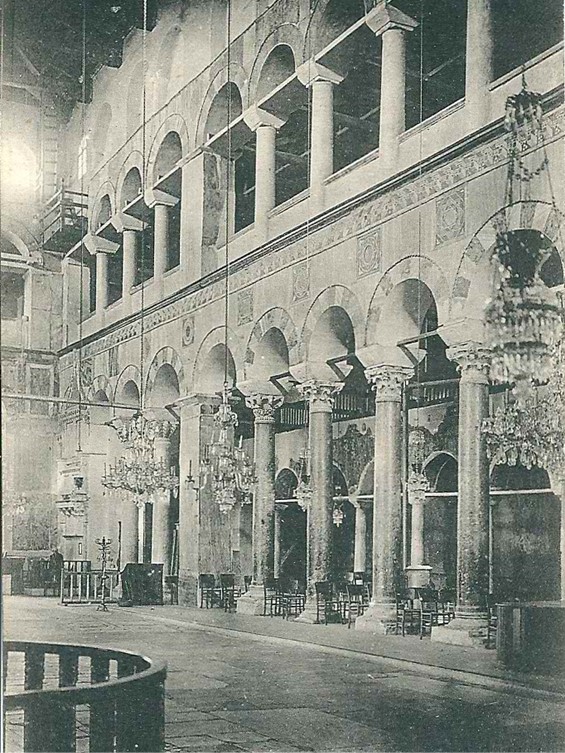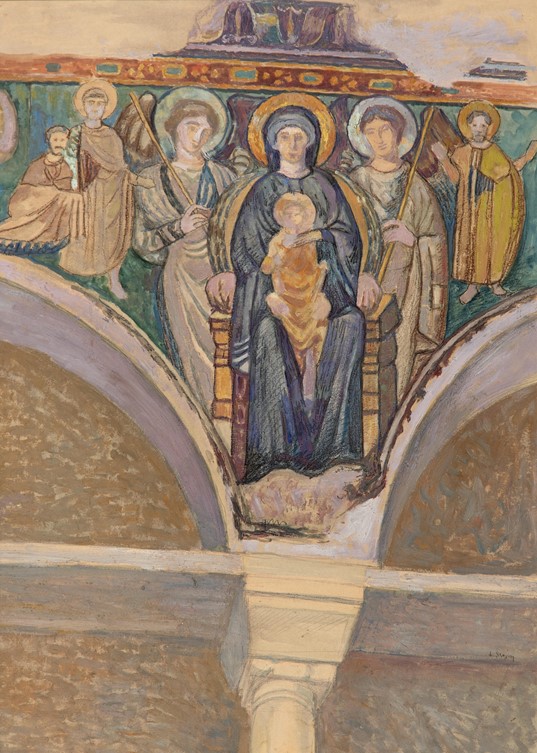
Watercolour Painting of the North Inner Aisle Mosaics in the Church of Saint Demetrios in Thessaloniki, 1907 (Mosaics date to the century), Sheet No. 2, Watercolour on Paper, 35.56x 45.72 cm, Photographic Library of the Warburg Institute, London, UK
Konstantinos Males, Greek artist, 1879-1928
Religious Scene, oil on card laid on canvas, 67 x 47 cm, Private Collection
https://www.mutualart.com/Artwork/Religious-Scene/7FC6668E4C9D5951
I have to confess; I was not familiar with Konstantinos Maleas’s painting Religious Scene in Thessaloniki depicting the Enthroned Virgin with Child and attendant Angels. I do not own the 2000 Adam publications book on Maleas by Prof. A. Kottidis, where, apparently, on page 83, the painting Religious Scene was first presented (another embarrassing confession!). To my defense, I am familiar with a painting of the same religious scene (Mary, Child, and Angels) by Walter S. George, a British architect, who, in 1909, while still a student at the Royal Institute of British Architects, was commissioned by the British School at Athens to go to Thessaloniki and participate in a project to publish a corpus of its Byzantine Monuments including the mosaic composition of the Enthroned Mary. Is it a mere coincidence? https://www.politeianet.gr/books/9789605003616-kotidis-antonis-adam-konstantinos-maleas-1879-1928-110647

Watercolour Painting of the North Inner Aisle Mosaics in the Church of Saint Demetrios in Thessaloniki, 1907 (Mosaics date to the century), Sheet No. 2, Watercolour on Paper, 35.56x 45.72 cm, Photographic Library of the Warburg Institute, London, UK
The years George was working in Thessaloniki, 1906/7-1909 were crucial for the city and the British interest in Byzantine Art. On the 1st of August 1907, the Ottoman authorities embarked on major renovations on Casimir Camii, originally the Byzantine Church of Hagios Demetrios, and in the course of repairs, an unexpected discovery occurred… unknown, magnificent mosaics, quite well preserved, on the wall of the North Inner Aisle of the almost dilapidated Church came to light, astonishing the world! George put himself to work, and on the 1st of September 1909, he delivered a set of eighteen sheets of coloured drawings to his patrons at the Byzantine Research and Publication Fund in London. Sheet No.2 of the set, depicts the Mosaics over spandrel C of the inner aisle colonnade and, extending asymmetrically, over arches 3 and 4 (from left to right). The discovered mosaics, among them the Enthroned Virgin, were of high quality and well preserved, stirring the interest of Byzantinologists around the world who rushed to Thessaloniki to study and document them.


Religious Scene, oil on card laid on canvas, 67 x 47 cm, Private Collection
https://www.mutualart.com/Artwork/Religious-Scene/7FC6668E4C9D5951
Konstantinos Maleas is one of my favourite early 20th century Greek artists. A Romios by birth, and a graduate of the Great School of the Nation in Constantinople, Maleas studied Architecture in Paris and eventually Painting, at the École des Arts Décoratifs, and under the tutelage of the Neo-Impressionist Henri Martin (1901-1908). After completing his studies in Paris, Maleas returned to Istanbul, traveled extensively in the Middle East and Egypt, published his exploits, got married, and in November 1913, settled in Thessaloniki as chief engineer of the city’s Municipality.
Maleas’s Thessaloniki of 1913 was no more the city Walter S. George documented in 1907/9. During the course of the First Balkan War, advancing without hindrance, the Greek Army found itself outside Thessaloniki, exactly on the eve of the Hagios Demetrios’s feast day. Late in the evening of the 26th of October, 1912, Hassan Tashin Pasha, Commander of the Turkish Eighth Army Corps, signed the protocol authorizing the surrender of the city to Constantine, Heir Presumptive, and Commander-in-Chief of the Greek Army at the time. After almost half a millennium of Ottoman rule, Thessaloniki became a Greek city once again. The Church of Hagios Demetrios and its beautiful mosaics were a Byzantine monument, residents and sightseers felt drawn to visit, pay their respects, photograph… and rarely, like Konstantino Malea document in painting! His beautiful Religious Scene is yet another testament of how important these newly discovered mosaics were among specialists like Walter S. George and art aficionados like Konstantinos Maleas. https://www.mutualart.com/Artwork/Religious-Scene/7FC6668E4C9D5951
Then, disaster stroke on the 5th of August 1917… a great fire swept through the thriving city of Thessaloniki destroying two-thirds of the city’s center, including the magnificent Church of Hagios Demetrios and leaving more than 70,000 homeless. The beautiful Mosaics of the Church’s North Inner Aisle discovered in 1907 were gone forever! Few photographs and even fewer paintings, created with care and sensitivity by artists like Walter S. George and Konstantinos Maleas are all that remains. …..
For a Student Activity on Maleas’s A Religious Scene in Thessaloniki, please… Check HERE!